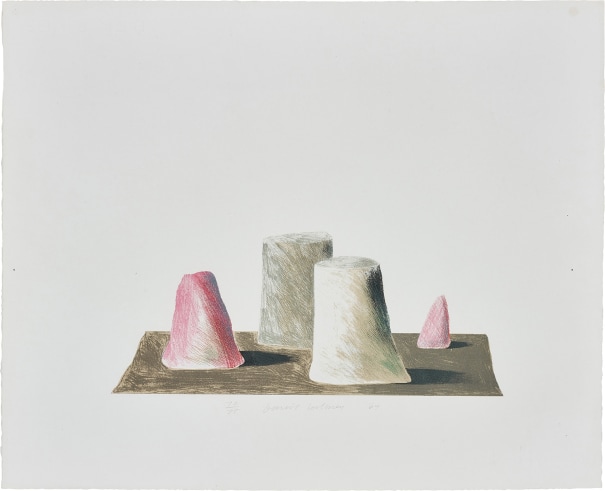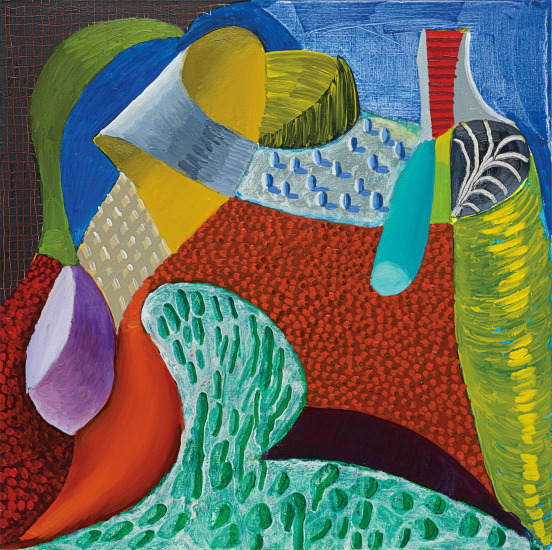David Hockney 30 Sunflowers 1996 Oil on canvas. 72 x 72 in. (182.9 x 182.9 cm.) Signed, titled and dated “30 Sunflowers, 1996, David Hockney” on the reverse.
Provenance Annely Juda Fine Art, London; Private Collection Exhibited London, Annely Juda Fine Art, David Hockney Flowers, Faces and Spaces, May 1 – July 19, 1997 (illustrated in color and on the cover) Literature A. Juda, David Hockney Flowers, Faces and Spaces, London, 1997 (illustrated in color and on the cover) Catalogue Essay Like Van Gogh, Matisse, Manet and countless other master painters before him, David Hockney has produced some of the most stunning and arresting still life paintings of flowers. While Hockney has painted myriad versions of this still life theme throughout his entire career, a brief period in 1996 saw the artist vigorously focus on a series of twenty-five flower paintings, each dynamic, vibrant and successful in their own ways. The present lot, 30 Sunflowers, 1996, is a superb, even sublime example of Hockney at his best with the subject matter. Of the twenty-five paintings which comprise the series, only two were made in the grand scale that 30 Sunflowers occupies; the other being the slightly less intricate and visually exciting Halaconia in Green Vase. 30 Sunflowers, along with all the other Flower paintings from 1996 were exhibited together in Hockney’s exhibition entitled Flowers, Faces and Spaces in 1997 at Annely Juda Fine Art in London. This exhibition was hugely important for Hockney, as it not only represented his largest show in his native London since the travelling retrospective the Tate held in 1988 (which later travelled to the L.A. County Museum of Art), but was also his first show with a British art dealer in over 10 years. This flower series marked a significant departure for Hockney as his technique became significantly more painterly than with his previous work and his palette took on a more vibrant and pulsating quality. These two factors paired with his ever present curious yet careful and informed study of perception and representation of space helped Hockney to achieve the simultaneously joyous and loose yet sophisticated and accomplished flower paintings exemplified by 30 Sunflowers. How Hockney came to embark on the series is two-fold. On one hand there was his use or even reliance on painting pictures of flowers in times when he was coping with ill and dying friends; and on the other was the critical affect seeing the Vermeer exhibition at the Mauritshaus in The Hague the previous summer had on him. Hockney once said “I have always painted flowers for friends who were ill.” Sadly but importantly during the time just prior to beginning work on this series Hockney was coping with several significant losses including the death of his great friend and champion Henry Geldzahler as well as the sudden death of his close friend Sandra Fisher painter and wife of R.B. Kitaj. The passing of these two central figures in Hockney’s life no doubt tried him intensely and forced him to examine the delicacy and transience of life. While some would become depressed and haunted by these significant losses, Hockney clearly remained optimistic and continued to celebrate life by producing these cheerful pictures rather than dwell on the inescapable process of death and decay. In fact, a few years before 30 Sunflowers was painted a journalist questioned Hockney about the death of his friends and whether or not it had affected his work in a negative manner; Hockney replied by describing how he felt after seeing the Matisse retrospective at MoMA in 1993: “I spent about five hours in there. It was one of the highest and deepest pleasures I’ve had. But I remember there was a painting if a little still life, just a pot of flowers and a bust on a table, and it’s painted in 1942. You look at the date and you think, in Europe they were just ripping themselves apart. It’s ghastly … I’m glad he painted it. I’m very glad somebody sat down and did something like that” (Hockney, quoted in T. Gabriel, “At Home with David Hockney”, in The New York Times, 21 January 1993, reproduced at www.nytimes.com). So what b
David Hockney 30 Sunflowers 1996 Oil on canvas. 72 x 72 in. (182.9 x 182.9 cm.) Signed, titled and dated “30 Sunflowers, 1996, David Hockney” on the reverse.
Provenance Annely Juda Fine Art, London; Private Collection Exhibited London, Annely Juda Fine Art, David Hockney Flowers, Faces and Spaces, May 1 – July 19, 1997 (illustrated in color and on the cover) Literature A. Juda, David Hockney Flowers, Faces and Spaces, London, 1997 (illustrated in color and on the cover) Catalogue Essay Like Van Gogh, Matisse, Manet and countless other master painters before him, David Hockney has produced some of the most stunning and arresting still life paintings of flowers. While Hockney has painted myriad versions of this still life theme throughout his entire career, a brief period in 1996 saw the artist vigorously focus on a series of twenty-five flower paintings, each dynamic, vibrant and successful in their own ways. The present lot, 30 Sunflowers, 1996, is a superb, even sublime example of Hockney at his best with the subject matter. Of the twenty-five paintings which comprise the series, only two were made in the grand scale that 30 Sunflowers occupies; the other being the slightly less intricate and visually exciting Halaconia in Green Vase. 30 Sunflowers, along with all the other Flower paintings from 1996 were exhibited together in Hockney’s exhibition entitled Flowers, Faces and Spaces in 1997 at Annely Juda Fine Art in London. This exhibition was hugely important for Hockney, as it not only represented his largest show in his native London since the travelling retrospective the Tate held in 1988 (which later travelled to the L.A. County Museum of Art), but was also his first show with a British art dealer in over 10 years. This flower series marked a significant departure for Hockney as his technique became significantly more painterly than with his previous work and his palette took on a more vibrant and pulsating quality. These two factors paired with his ever present curious yet careful and informed study of perception and representation of space helped Hockney to achieve the simultaneously joyous and loose yet sophisticated and accomplished flower paintings exemplified by 30 Sunflowers. How Hockney came to embark on the series is two-fold. On one hand there was his use or even reliance on painting pictures of flowers in times when he was coping with ill and dying friends; and on the other was the critical affect seeing the Vermeer exhibition at the Mauritshaus in The Hague the previous summer had on him. Hockney once said “I have always painted flowers for friends who were ill.” Sadly but importantly during the time just prior to beginning work on this series Hockney was coping with several significant losses including the death of his great friend and champion Henry Geldzahler as well as the sudden death of his close friend Sandra Fisher painter and wife of R.B. Kitaj. The passing of these two central figures in Hockney’s life no doubt tried him intensely and forced him to examine the delicacy and transience of life. While some would become depressed and haunted by these significant losses, Hockney clearly remained optimistic and continued to celebrate life by producing these cheerful pictures rather than dwell on the inescapable process of death and decay. In fact, a few years before 30 Sunflowers was painted a journalist questioned Hockney about the death of his friends and whether or not it had affected his work in a negative manner; Hockney replied by describing how he felt after seeing the Matisse retrospective at MoMA in 1993: “I spent about five hours in there. It was one of the highest and deepest pleasures I’ve had. But I remember there was a painting if a little still life, just a pot of flowers and a bust on a table, and it’s painted in 1942. You look at the date and you think, in Europe they were just ripping themselves apart. It’s ghastly … I’m glad he painted it. I’m very glad somebody sat down and did something like that” (Hockney, quoted in T. Gabriel, “At Home with David Hockney”, in The New York Times, 21 January 1993, reproduced at www.nytimes.com). So what b
.jpg)
.jpg)




.jpg)
.jpg)
.jpg)
.jpg)
.jpg)

Testen Sie LotSearch und seine Premium-Features 7 Tage - ohne Kosten!
Lassen Sie sich automatisch über neue Objekte in kommenden Auktionen benachrichtigen.
Suchauftrag anlegen